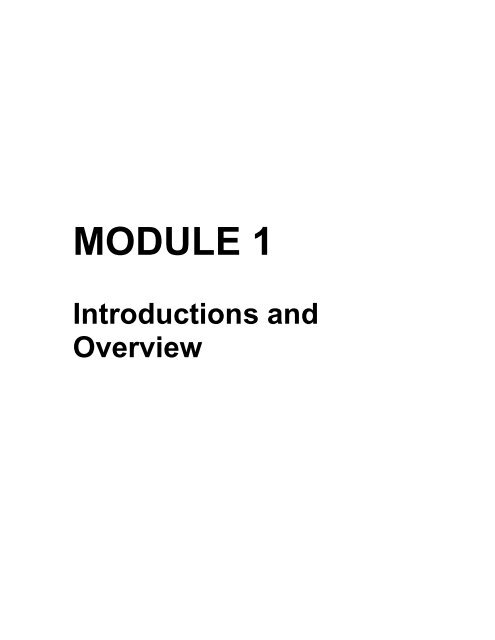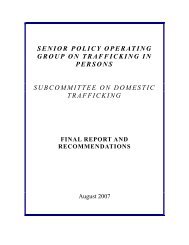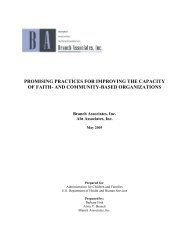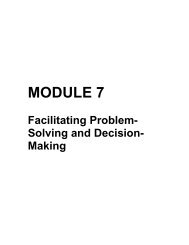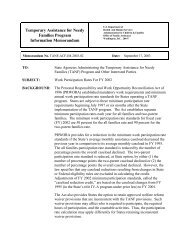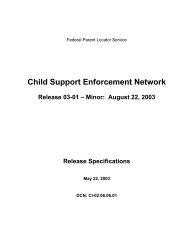Module 1: Introductions and Overview
Module 1: Introductions and Overview
Module 1: Introductions and Overview
Create successful ePaper yourself
Turn your PDF publications into a flip-book with our unique Google optimized e-Paper software.
MODULE 1<strong>Introductions</strong> <strong>and</strong><strong>Overview</strong>
Facilitation Skills for Child Support Enforcement StaffFacilitator GuideTRAINING NOTESWhat you need to know1. It will take approximately 50 minutes to complete the following topics in thismodule.TOPICWelcome <strong>and</strong> <strong>Module</strong> ObjectivesExercise: Networking IcebreakerParticipant ExpectationsWorkshop <strong>Overview</strong><strong>Module</strong> 1 Key Points <strong>and</strong> Transition2. The equipment <strong>and</strong> supplies you will need for this module are listed below:• Computer projection system <strong>and</strong> screen• PowerPoint slides 1-1 through 1-4• 3x5 index cards (for networking exercise)• Name tents or name tags• Flipchart easel with pad of paper• Colored markers• Masking tape• Small size Post-It notes for marking Reflection exercises• Facilitator Guide• Participant Guides.3. The list of questions <strong>and</strong> answers used in the Networking Icebreaker exercisebegins on page 1-13. Use the prepared question <strong>and</strong> answer index cards forthe Networking Icebreaker exercise. There are a total of 40 cards; 20 withquestions <strong>and</strong> the other 20 with answers. Therefore, the cards can bedistributed to up to 40 participants. Be sure they are in r<strong>and</strong>om order fordistribution.4. Prepare <strong>and</strong> post a flipchart page titled, Welcome to the Facilitation SkillsWorkshop.5. Prepare a Ground Rules flipchart page that lists ground rules for theworkshop. It is recommended you list no more than six to eight ground rules.For example: Participate actively, Be open to new ideas, Respect others,Honor time agreements, etc.6. Be sure copies of the Participant Guide <strong>and</strong> name tags or name tents areplaced on the tables before participants arrive.<strong>Module</strong> 1: <strong>Introductions</strong> <strong>and</strong> <strong>Overview</strong> 1-1
Facilitator GuideFacilitation Skills for Child Support Enforcement StaffTRAINING NOTESWhat you need to say/doWELCOME AND MODULE OBJECTIVES1. Welcome participants to the Facilitation Skills for Child Support Enforcement StaffWorkshop. Express appreciation for their willingness to participate in this importantworkshop <strong>and</strong> desire to improve their facilitation skills.2. Introduce yourself by stating your name, your role in the organization, <strong>and</strong> yourexperience as a facilitator.3. Show slide 1-1, <strong>Module</strong> 1 Objectives. Explain the objectives.• Through a Networking Icebreaker exercise, you will begin the process of buildinga facilitator network.• After the exercise, you will identify answers to questions related to facilitation.• After an overview of the workshop, you will identify the key topics to be covered.4. Explain that each of the workshop modules is designed to help participants gain theknowledge <strong>and</strong> skills required to be effective facilitators.EXERCISE: NETWORKING ICEBREAKER1. Explain that having a network of other facilitators can help participants learn fromeach other <strong>and</strong> serves as a valuable resource. State that this exercise will not onlygive them an opportunity to begin building a network by getting to know theparticipants in this workshop, but answer some questions related to facilitation.2. Distribute a set of index cards to each table group (one for each participant). Ask thetable groups to ensure each person has one card.3. Explain that the card each participant received contains either a question related tofacilitation skills or an answer related to one of the facilitation skills questions. Pointout that the cards have been r<strong>and</strong>omly distributed throughout the room.4. State that the task for each participant is to find the person in the room who haseither the answer to his or her question or the question that fits his or her answer.Encourage participants to introduce themselves to the other people they meet beforedetermining if there is a match.What you need to know1. The Networking Icebreaker exercise will take approximately 30 minutes.1-2 <strong>Module</strong> 1: <strong>Introductions</strong> <strong>and</strong> <strong>Overview</strong>
Facilitation Skills for Child Support Enforcement StaffParticipant Guide PageMODULE 1: INTRODUCTIONS AND OVERVIEWMODULE 1 OBJECTIVES• Build a facilitator network• Answer questions related tofacilitation• Identify the key topics of theworkshop1-1Learning Objectives• In a Networking Icebreaker exercise, you will introduce yourselves <strong>and</strong> learnmore about each other.• After the exercise, you will identify the answers to questions related tofacilitation.• After an overview of the workshop, you will identify the key topics to becovered.Learning GoalThis module’s learning goal is to begin the process of building a facilitatornetwork <strong>and</strong> learn how the workshop is structured to help you gain theknowledge <strong>and</strong> skills required to be effective facilitators.(Participant Guide 1-1)<strong>Module</strong> 1: <strong>Introductions</strong> <strong>and</strong> <strong>Overview</strong> 1-3
Facilitator GuideFacilitation Skills for Child Support Enforcement StaffTRAINING NOTESWhat you need to say/doEXERCISE: NETWORKING ICEBREAKER, CONTINUED5. Explain that if two participants match up, they should stay where they are <strong>and</strong>get to know each other a little better so that they can introduce their partner tothe rest of the group. They are to find out where the other person is from,how long he or she has been with Child Support Enforcement, what his or herrole is, <strong>and</strong> one “fun” fact about that person.6. Mention that after 10 minutes you will stop the process <strong>and</strong> see how they’vedone.7. Encourage participants to move around the room to find a match. Expectsome chaos—the more the better.8. After about 10 minutes, ask them to stop the exercise. Have participantsremain where they are.9. Use the list of questions <strong>and</strong> answers beginning on page 1-13 <strong>and</strong> thefollowing process to complete the exercise:• Ask the person who has question #1 to read the question. Ask his or herpartner to read the matched answer.• Acknowledge the correct answer.• Ask them to briefly introduce their partners to the group.• Repeat for subsequent questions <strong>and</strong> introductions until complete.10. Summarize the exercise by emphasizing that participants will have anopportunity during the workshop to continue networking <strong>and</strong> getting to knoweach other.11. Ask participants to return to their seats.PARTICIPANT EXPECTATIONS1. Ask each participant to identify the most valuable thing he or she could learnthat would help him or her to be a more effective facilitator.2. Write the participants’ responses on the flipchart. Post the page(s) on a wallfor future reference.1-4 <strong>Module</strong> 1: <strong>Introductions</strong> <strong>and</strong> <strong>Overview</strong>
Facilitation Skills for Child Support Enforcement StaffParticipant Guide Page(This page is left intentionally blank.)<strong>Module</strong> 1: <strong>Introductions</strong> <strong>and</strong> <strong>Overview</strong> 1-5
Facilitator GuideFacilitation Skills for Child Support Enforcement StaffTRAINING NOTESWhat you need to say/doWORKSHOP OVERVIEW1. Show slides 1-2 <strong>and</strong> 1-3, Workshop <strong>Overview</strong>.2. Explain the key topics that will be covered in the workshop. As you reviewthe topics, link participants’ expectations to the relevant topics.• Beginning with the next module, we will compare the roles of the leader,manager, <strong>and</strong> facilitator <strong>and</strong> the factors to consider when you mustchoose between the roles. You will also be introduced to a model forfacilitation <strong>and</strong> its key elements.• In <strong>Module</strong> 3, we will explore how we can use our knowledge of ourselvesto improve our facilitation <strong>and</strong> help our groups. We’ll learn about theimportance of recognizing individual differences in particular learningstyles <strong>and</strong> about specific adult learning requirements.• Next, we’ll discuss the topic of team development. We will identify thestages that all groups go through as they mature <strong>and</strong> learn to worktogether as a team. We’ll also demonstrate the dynamics of teaminteraction <strong>and</strong> participation.• As an introduction to the next key topic, you will complete an assessmentof your “core” facilitation skills that help to engage people <strong>and</strong> increaseparticipation <strong>and</strong> commitment. You will practice the skills of Attending,Listening, Questioning, Summarizing, <strong>and</strong> Providing Feedback.• Then we’ll take a journey down “The Facilitator’s Nightmare Alley.” This iswhere all the challenging <strong>and</strong> disruptive behaviors reside. You’ll learn <strong>and</strong>practice strategies for h<strong>and</strong>ling these tough situations.• Next, we’ll learn some tools <strong>and</strong> techniques that help you facilitate groupstasked with problem-solving <strong>and</strong> decision-making outcomes. We’ll alsolook at three different decision-making methods <strong>and</strong> you will have anopportunity to practice choosing the correct decision-making method touse in a particular situation.• In <strong>Module</strong> 8, we’ll identify tips <strong>and</strong> techniques for effectively facilitatingaudio- <strong>and</strong> videoconferencing sessions. We’ll also look at guidelines thathelp in moderating panel discussions.• In the final module, you’ll identify key learnings from the workshop <strong>and</strong>how you will apply your learning to improve your facilitation.1-6 <strong>Module</strong> 1: <strong>Introductions</strong> <strong>and</strong> <strong>Overview</strong>
Facilitation Skills for Child Support Enforcement StaffParticipant Guide PageWORKSHOP OVERVIEWWORKSHOP OVERVIEW• <strong>Module</strong> 2: The roles of leader, manager,<strong>and</strong> facilitator• <strong>Module</strong> 3: Underst<strong>and</strong>ing self <strong>and</strong> others• <strong>Module</strong> 4: Team development <strong>and</strong> teamdynamics• <strong>Module</strong> 5: Facilitating participation1-2WORKSHOP OVERVIEW,continued• <strong>Module</strong> 6: Challenging behaviors• <strong>Module</strong> 7: Problem-solving <strong>and</strong> decisionmakingtools• <strong>Module</strong> 8: Facilitating with technology• <strong>Module</strong> 9: Wrap-up1-3(Participant Guide 1-2)<strong>Module</strong> 1: <strong>Introductions</strong> <strong>and</strong> <strong>Overview</strong> 1-7
Facilitator GuideFacilitation Skills for Child Support Enforcement StaffTRAINING NOTESWhat you need to say/doWORKSHOP OVERVIEW, CONTINUED3. Explain how the Participant Guide is organized.• The Participant Guide is organized by module. Each module containscontent material <strong>and</strong> exercises that relate to the topics covered in thatmodule.• The Participant Guide also contains Reflection exercises. After a majortopic, you will be asked to reflect on what you’ve learned about the topic<strong>and</strong> complete the related exercise. These “reflections” will help you toidentify areas of strength <strong>and</strong> areas in which you would like to improve.• At the end of the workshop, you will refer to these exercises to help youidentify key learnings. You may want to mark the exercises using yellowPost-It notes.4. Provide any administrative information necessary such as start/end times,breaks, <strong>and</strong> locations of phones <strong>and</strong> restrooms.5. Refer the participants to the prepared flipchart page titled, Ground Rules.Review the ground rules <strong>and</strong> obtain participants’ buy-in.MODULE 1 KEY POINTS AND TRANSITION1. Show slide 1-4, <strong>Module</strong> 1 Key Points.• Having a network of facilitators can help you learn from each other, have a“sounding board,” <strong>and</strong> provide you with help in problem solving.• This workshop will provide you with the necessary knowledge <strong>and</strong> skills tobe an effective facilitator.2. In <strong>Module</strong> 2 we will be talking about the role of the facilitator.1-8 <strong>Module</strong> 1: <strong>Introductions</strong> <strong>and</strong> <strong>Overview</strong>
Facilitation Skills for Child Support Enforcement StaffParticipant Guide PageMODULE 1 KEY POINTSMODULE 1 KEY POINTS• A network of facilitators can serve as avaluable resource for you• The workshop is designed to provide youwith the knowledge <strong>and</strong> skills necessary tobe an effective facilitator1-4(Participant Guide 1-3)<strong>Module</strong> 1: <strong>Introductions</strong> <strong>and</strong> <strong>Overview</strong> 1-9


